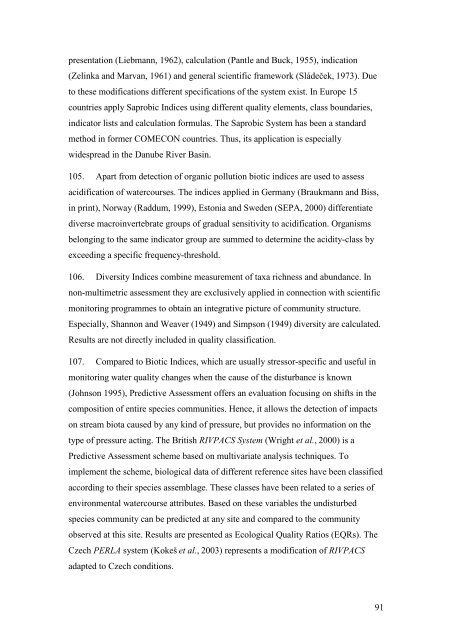Report on Harmonisation of freshwater biological methods
Report on Harmonisation of freshwater biological methods
Report on Harmonisation of freshwater biological methods
You also want an ePaper? Increase the reach of your titles
YUMPU automatically turns print PDFs into web optimized ePapers that Google loves.
presentati<strong>on</strong> (Liebmann, 1962), calculati<strong>on</strong> (Pantle and Buck, 1955), indicati<strong>on</strong>(Zelinka and Marvan, 1961) and general scientific framework (Sládeek, 1973). Dueto these modificati<strong>on</strong>s different specificati<strong>on</strong>s <strong>of</strong> the system exist. In Europe 15countries apply Saprobic Indices using different quality elements, class boundaries,indicator lists and calculati<strong>on</strong> formulas. The Saprobic System has been a standardmethod in former COMECON countries. Thus, its applicati<strong>on</strong> is especiallywidespread in the Danube River Basin.105. Apart from detecti<strong>on</strong> <strong>of</strong> organic polluti<strong>on</strong> biotic indices are used to assessacidificati<strong>on</strong> <strong>of</strong> watercourses. The indices applied in Germany (Braukmann and Biss,in print), Norway (Raddum, 1999), Est<strong>on</strong>ia and Sweden (SEPA, 2000) differentiatediverse macroinvertebrate groups <strong>of</strong> gradual sensitivity to acidificati<strong>on</strong>. Organismsbel<strong>on</strong>ging to the same indicator group are summed to determine the acidity-class byexceeding a specific frequency-threshold.106. Diversity Indices combine measurement <strong>of</strong> taxa richness and abundance. Inn<strong>on</strong>-multimetric assessment they are exclusively applied in c<strong>on</strong>necti<strong>on</strong> with scientificm<strong>on</strong>itoring programmes to obtain an integrative picture <strong>of</strong> community structure.Especially, Shann<strong>on</strong> and Weaver (1949) and Simps<strong>on</strong> (1949) diversity are calculated.Results are not directly included in quality classificati<strong>on</strong>.107. Compared to Biotic Indices, which are usually stressor-specific and useful inm<strong>on</strong>itoring water quality changes when the cause <strong>of</strong> the disturbance is known(Johns<strong>on</strong> 1995), Predictive Assessment <strong>of</strong>fers an evaluati<strong>on</strong> focusing <strong>on</strong> shifts in thecompositi<strong>on</strong> <strong>of</strong> entire species communities. Hence, it allows the detecti<strong>on</strong> <strong>of</strong> impacts<strong>on</strong> stream biota caused by any kind <strong>of</strong> pressure, but provides no informati<strong>on</strong> <strong>on</strong> thetype <strong>of</strong> pressure acting. The British RIVPACS System (Wright et al., 2000) is aPredictive Assessment scheme based <strong>on</strong> multivariate analysis techniques. Toimplement the scheme, <strong>biological</strong> data <strong>of</strong> different reference sites have been classifiedaccording to their species assemblage. These classes have been related to a series <strong>of</strong>envir<strong>on</strong>mental watercourse attributes. Based <strong>on</strong> these variables the undisturbedspecies community can be predicted at any site and compared to the communityobserved at this site. Results are presented as Ecological Quality Ratios (EQRs). TheCzech PERLA system (Kokeš et al., 2003) represents a modificati<strong>on</strong> <strong>of</strong> RIVPACSadapted to Czech c<strong>on</strong>diti<strong>on</strong>s.91














![Accommodation booking form [PDF]](https://img.yumpu.com/39471785/1/184x260/accommodation-booking-form-pdf.jpg?quality=85)

